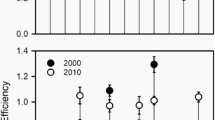Abstract
Eutrophication of coastal waters is a serious environmental problem with high costs for society globally. This is a development which demands immediate environmental action along many coastal sites. Since the 1980s, mussel farming has been recognized by Swedish environmental authorities as a possible measure to improve coastal water quality. Concepts and management strategies on how to increase mussel farming and thus combat coastal marine eutrophication has recently been developed in Sweden. The main principle of this development has been the implementation of nutrient trading as a management tool. This imposes demands on those who emit the pollution through the establishment of emission quotas, which are traded and bought by the emitter. The seller is a nutrient harvesting enterprise, e.g., a mussel farmer. This principle is particularly straightforward when the nutrients are discharged from a point source. When examining the nutrient supply from all diffuse sources, the situation is more complex. However, since the major part of the nutrient supply to coastal waters in many areas of Europe has its origin in agricultural operations, we suggest that the EU agro-environmental aid program could be extended into the coastal zone in order to combat eutrophication. In practice, this should involve support paid to mussel farming enterprises through their harvest of mussels (and thus their harvest of nutrients) in the same way as support is paid to agricultural farmers for operations that reduce nutrient leakage from their farmland. This is a simple, cost-effective and straightforward way of improving coastal water quality at many coastal sites that will, at the same time, provide coastal jobs. However, this eutrophication combat method depends on the EU agro-environmental aid program being extended beyond the shoreline.



Similar content being viewed by others
References
Anon., 2001. The Skagerrak—Environmental State and Monitoring Prospects. ISBN 91-89507-04-5 [Available at the Swedish Meteorological and Hydrological Institute, (SMHI)].
Anon., 2003. Havet—tid för en ny strategi. Betänkande av Havsmiljökommissionen. Statens offentliga utredningar. SOU 2003:72, 2003 (in Swedish with English summary).
Anon., 2004. Miljøokonomisk analyse af Mariager Fjord. CEA af Mariager Fjord. Aarhus-och Nordjyllands Amter. http://www.mariager-fjord.dk/Rapporter/indsatmuligheder/Miljøokonomisk%20analyse.pdf.
Berge, M. G. & E. Austreng, 1989. Blue mussel in feed for rainbow trout. Aquaculture 81: 79–90.
Cloern, J. E., 2001. Our evolving conceptual model of the coastal eutrophication problem. Marine Ecology Progress Series 210: 223–253.
Diaz, R. J. & R. Rosenberg, 1995. Marine benthic hypoxia. A review of its ecological effects and the behavioral responses of benthic macrofauna. Oceanography and Marine Biology: An Annual Review 33: 245–303.
Edebo, L., J. Haamer, O. Lindahl, L.-O. Loo & L. Piriz, 2000. Recycling of macronutrients from sea to land using mussel cultivation. Environmental Pollution 13: 190–207.
Elmgren, R., 1984. Trophic dynamics in the enclosed, brackish Baltic Sea. Rapports et Procés-verbaux des Réunions. Conseil International pour l’Éxploration de la Mer 183: 152–169.
Haamer, J., P.-O. Andersson, O. Lindahl, S. Lange, X. P. Li & L. Edebo, 1990. Geographic and seasonal variation of Okadaic acid content in farmed mussels, Mytilus edulis Linnaeus, 1758, along the Swedish west coast. Journal of Shellfish Research 9: 103–108.
Jönsson, L., 2007. Foderförsök med värphöns och kyckling. In Muslingemel i stedet for fiskemel i økologiske foder till æglæggende høns, kylling och andre husdyr. TemaNord 2007: 540 (in Swedish).
Kollberg, S. & L. Ljungqvist, 2007. Musslor som livsmedel och råvara inom lantbruket. Ekhaga Stiftelsen projekt: 2005: 48 (in Swedish).
Lindahl, O., 1995. Long-term studies of primary phytoplankton production in the Gullmar fjord, Sweden. In Skjoldal, H. R., C. Hopkins, K. E. Erikstad & H. P. Leinaas (eds), Ecology of Fjords and Coastal Waters. Elsevier Science Publishers B.V., Amsterdam: 105–112.
Lindahl, O., 2007. Primary production in the Gullmar Fjord. Swedish National Report on Eutrophication Status in the Kattegat and the Skagerrak. OSPAR Assessment 2007: 41–43.
Lindahl, O., R. Hart, B. Hernroth, S. Kollberg, L.-O. Loo, L. Olrog, A.-S. Rehnstam-Holm, J. Svensson, S. Svensson & U. Syversen, 2005. Improving marine water quality by mussel farming—a profitable measure for Swedish society. Ambio 34(2): 131–138.
Loo, L.-O. & R. Rosenberg, 1983. Mytilus edulis culture; growth and production in western Sweden. Aquaculture 35: 137–150.
Lutz, R. A. (ed.), 1980. Mussel Culture and Harvest: a North American Perspective. Elsevier Scientific Publishing Company, Amsterdam.
Newell, R. I. E., 2004. Ecosystem influences of natural and cultivated populations of suspension feeding bivalve molluscs: a review. Journal of Shellfish Research 23: 51–61.
Olrog, L. & E. Christensson, 2008. Användning av musslor och musselrester som gödselmedel i jordbruket. The Rural Economy and Agricultural Societies Report 2008: 1 (in Swedish with English summary).
Petersen, J. K. & L.-O. Loo, 2004. Miljøkonsekvenser af dyrking av blåmuslinger. Interregproject III-A “Blåskjellanlegg og nitrogenkvoter”. Slutrapport 31.8.2004 (in Danish).
Riisgård, H. U. & A. Randløv, 1981. Energy budgets, growth and filtration rates in Mytilus edulis at different algal concentrations. Marine Biology 61: 227–234.
Ryther, J. H., W. M. Dunstan, K. R. Tenore & J. E. Huguenin, 1972. Controlled eutrophication: increased food production from the sea by recycling human wastes. BioScience 22: 144–152.
Sánches-Hjortberg, A., 2003. Blåmusselodling på västkusten, ett projektarbete vid SLU:s Vattenbruksinstitution [Available at the Swedish Agricultural University] (in Swedish).
Smaal, A. C., 2002. European mussel cultivation along the Atlantic coast: production status, problems and perspectives. Hydrobiologia 484: 89–98.
Acknowledgment
The authors would like to thank Dr. Max Troell for valuable and constructive criticism.
Author information
Authors and Affiliations
Corresponding author
Additional information
Guest editors: J. H. Andersen & D. J. Conley
Eutrophication in Coastal Ecosystems: Selected papers from the Second International Symposium on Research and Management of Eutrophication in Coastal Ecosystems, 20–23 June 2006, Nyborg, Denmark
Rights and permissions
About this article
Cite this article
Lindahl, O., Kollberg, S. Can the EU agri-environmental aid program be extended into the coastal zone to combat eutrophication?. Hydrobiologia 629, 59–64 (2009). https://doi.org/10.1007/s10750-009-9771-3
Published:
Issue Date:
DOI: https://doi.org/10.1007/s10750-009-9771-3




